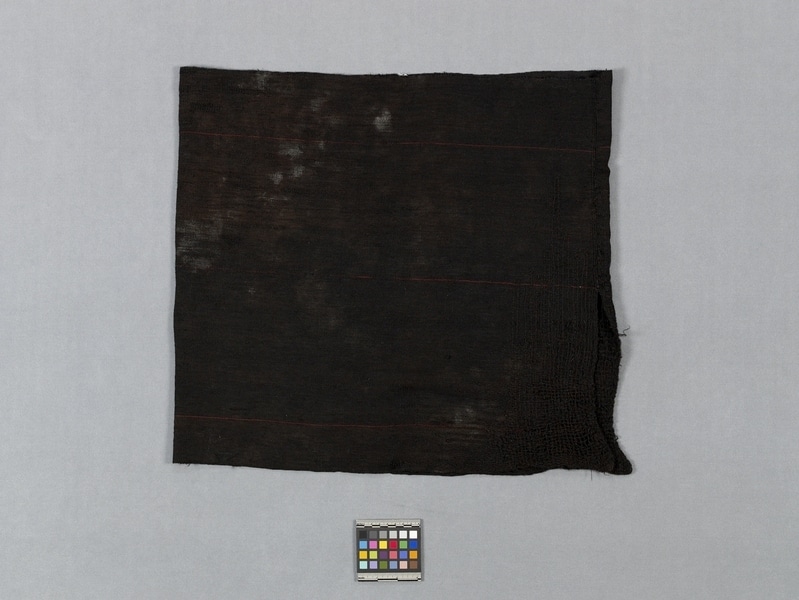Bodice Item Number: Sf1015 from the MOA: University of British Columbia


Description
Bodice composed of a rectangle of black fabric sewn together at the ends to form a tube. The two corners that are not sewn together are darned with a thick black thread, which replaces the cloth. Three fine red stripes run horizontally.
History Of Use
Warp-faced fabric with three or four selvedges, woven by women but the fabrics are used by both sexes. The techniques, structures, and some of the motifs have pre-Conquest antecedents. This type of textile conveys the most information about an individual's ethnicity, sex, age, status, and particular history. Earlier this century, women wore a warp-faced black skirt (aksu) and separate bodice (tipana). The tipana was worn over a white blouse and secured at the shoulders with stick pins (tupus). Bayeta skirts and blouses, made from yardage woven by males on the treadle loom, replaced the asku and tipana, and today, factory-made sweaters of brillant, pink synthetic yarn are the most usual clothing for women.
Narrative
The weaving and spinning was done by the grandmother, now dead. The seller, trefona, fashioned the bodice or tipana from one loom width of a carrying cloth. She undid the centre seam then folded the loom width in half transversely and sewed together the 2 ends, leaving a slit for an armhole. Trefona demonstrated how the tipana was worn. The tube of fabric was slipped over her head over top of a white blouse. The fabric at the back of the shoulders was pulled across to the front of the shoulders and secured with a spoon-shaped pin.
Specific Techniques
Z spun, 2 ply s warps, probably made of one strand alpaca and one strand sheep's wool. Weft probably sheep's wool. Woven in warp-faced plain weave. 3 fine red warp stripes. 2 corners extensively darned with coarsely spun and plied yarn. 2 warp selvedges seamed together with a flat figure 8 stitch.
Item History
- Made by Candelaria Flores Machaca (Maker) in Taquile, Puno, Peru during 1910
- Collected by Mary Frame during 1987
- Owned by Trefona Marca Quispe
- Owned by Mary Frame before November 3, 1987
- Received from Mary Frame (Seller) and Museum of Anthropology Shop Volunteers (Funding source) on November 3, 1987
What
- Name
- Bodice
- Identification Number
- Sf1015
- Type of Item
- bodice
- Material
- alpaca wool fibre and wool fibre
- Manufacturing Technique
- spun, plied, woven and sewn
- Overall
- height 51.5 cm, width 59.0 cm
Who
- Culture
- Quechua
- Creator
- Candelaria Flores Machaca (Maker)
- Field Collector
- Mary Frame
- Previous Owner
- Trefona Marca Quispe and Mary Frame
- Received from
- Mary Frame (Seller) and Museum of Anthropology Shop Volunteers (Funding source)
Where
- Holding Institution
- MOA: University of British Columbia
- Made in
- Taquile, Puno, Peru
When
- Creation Date
- during 1910
- Collection Date
- during 1987
- Ownership Date
- before November 3, 1987
- Acquisition Date
- on November 3, 1987
Other
- Item Classes
- textiles
- Condition
- poor
- Accession Number
- 1274/0011